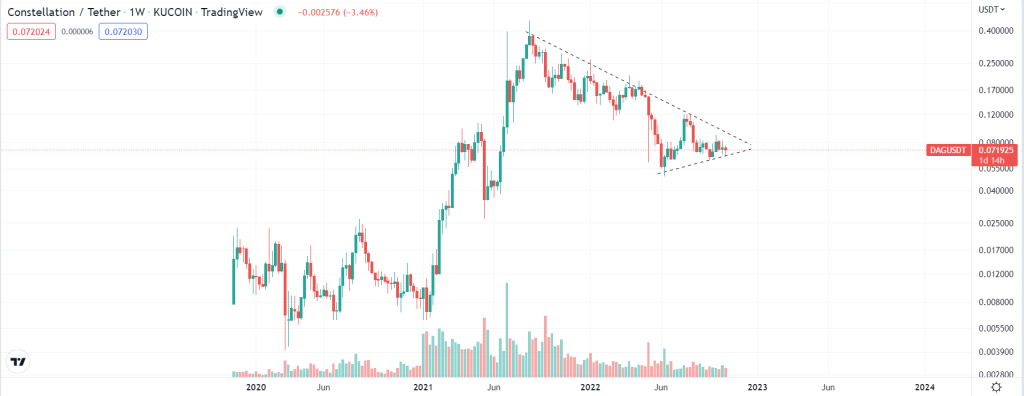Key Takeaways:
- Constellation Network helps onboard businesses to Web3.0 through a wide range of tools
- It can be used to create cryptocurrencies, blockchains, or applications depending on the developer’s needs.
- Constellation’s Proof of Reputable Observation (PRO) consensus allows a broad range of devices to validate transactions on the network
___________________________________________
Ever since Bitcoin was invented 13 years ago, many layer-1s have been trying to incorporate blockchain technology into their daily operation and business to reap its benefits. Yet, these projects often struggle to overcome a series of challenges leading to the birth of many more blockchains all trying to solve “an existing problem.”
Challenges include complex business processes, an abundance of data that needs to be processed, and the lack of technical know-how regarding blockchain technology. Unfortunately, the status quo of many blockchains are not just limited to scalability and customization but also lack transaction speed and are costly in their use tends to worsen the situation these projects encounter.
In light of bringing an end to this dilemma, Constellation Network pledges to bridge real-world businesses with blockchain technology by offering a user-friendly framework with open-source developer tools, vast scalability, and a free and highly-secure network.
Also Read: Slaying The Bear Market: 5 Skills You Need To Excel In a Crypto Downturn
What is Constellation Network?
Launched in 2017, Constellation Network is an open-source decentralized platform with reliable data assurance, a comprehensible framework and developer tools that allow everyone to build and conduct business on it.
Say hello to our new and improved website at https://t.co/wRkfHeHiCJ ✨
— Constellation Network (@Conste11ation) September 2, 2022
A Clean, Sleek and Elevated design.
For you to Learn, Build & Explore 🚀$DAG #HGTP pic.twitter.com/1mQAYZdD02
It can be used to create cryptocurrencies, blockchains, or applications depending on the developer’s needs.
The platform was built by Constellation Network, a software and blockchain company headquartered in San Francisco, California. The team’s primary goal is to encourage blockchain entrepreneurs to build scalable businesses as well as enable developers to build Web 3.0 applications with increased security.
How Does Constellation Network Work?
Constellation Network democratizes existing digital infrastructures and acts as a global accounting, notarization, and audit layer of all digital information and activity.
It has developed the core infrastructure and rails through Hypergraph Network to transact currency and index to the network via its native coin $DAG.
The most awaited #HypergraphHour🚀 is scheduled for next 📅Wednesday, September 28 at 12PM PT ⏰
— Constellation Network (@Conste11ation) September 23, 2022
On this day, Mainnet 2.0's genesis block will be created.
A milestone for all of us, one not to miss.$DAG #HGTP pic.twitter.com/VUgHY7VE6V
It has also established the programmable interface for building solutions, the so-called Layer 0 standard, to merge the concept of data collection, exchange and transfer of value, and the ability to transact in an open network.
What is Hypergraph?
Hypergraph Network (HGTP) is a zero-fee decentralized network used for transaction validation. It’s a distributed ledger technology known as a Directed Acyclic Graph (DAG).

HGTP is divided into nodes. A node can send a transaction to several nodes, which then spreads the transaction across the network although it is not necessary to spread it to all nodes.
Constellation’s Proof of Reputable Observation (PRO) consensus allows a broad range of devices to validate transactions on the network. PRO is also called Proof-of-Meme, and it aims to secure honest nodes within the network.
As PRO is a reputation-based system, certain factors affect the reputation of a node for example availability, loyalty to the network integrity, and history of the network.
The data within the nodes flows in bundles and is categorized by rank. This feature creates a distributed model of operation with a high transactional throughput.
$DAG Coin
Constellation’s ecosystem is powered by its native coin $DAG. Its goal is to ensure a convenient, smooth, and secure mode of payment exchange between different state channels and nodes on the HGTP network. Its utilities include:
- Transaction fees: Although the Constellation Network is a feeless network, some of its functionalities that require higher throughput, such as serious data processing or data exchanges, are not exempted from transaction fees.
- Collateral for node operators: A user must stake a minimum of 250,000 $DAG to become a node operator.
- Network incentives: Node operators will be rewarded with $DAG to encourage them to continue contributing their resources to the network. An example was during two of these incentives, node operators are rewarded according to the number of transactions per second of HGTP.
- Governance: DAG is also the governance token in Constellation’s community governance.
$DAG Price History
Like the broader crypto market, $DAG is nowhere near its all-time highs. In fact, it is 85% away. Price has been capped by a descending trendline dating back to August 2021. If we get a rally in Q4 2022, $DAG may break out to the upside and see massive gains.
On the flip side of things, a breakdown of the ascending trendline will spell disaster for $DAG holders as they are lots of room to fall.

Conclusion
Constellation Network is a project that is dedicated to tackling existing blockchains issues that slow down the technology’s mass adoption. It can meet real-world requirements by offering a user-friendly framework with open-source developer tools, vast scalability, and a free and highly-secure network.
If Constellation can onboard real-world businesses, it is possible to achieve a high adoption rate. Constellation is definitely an exciting project and could be one to watch for in the future.
Also Read: Maximizing Returns in Crypto: Understanding The 4 Phases of a Market Cycle
[Editor’s Note: This article does not represent financial advice. Please do your own research before investing.]
Featured Image Credit: Chain Debrief



































